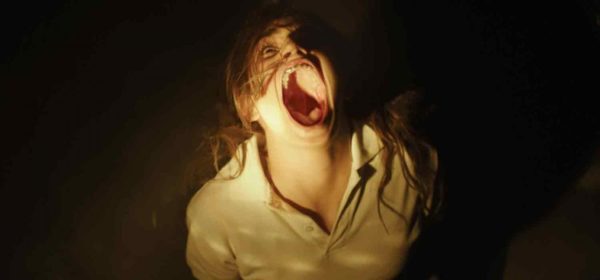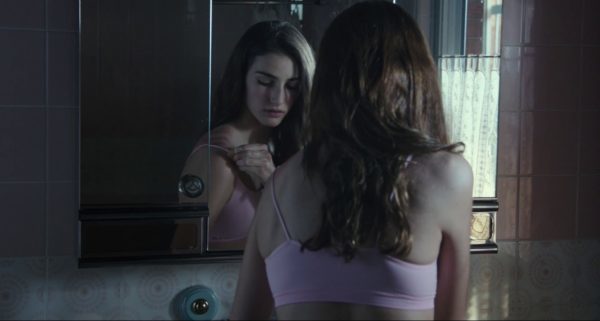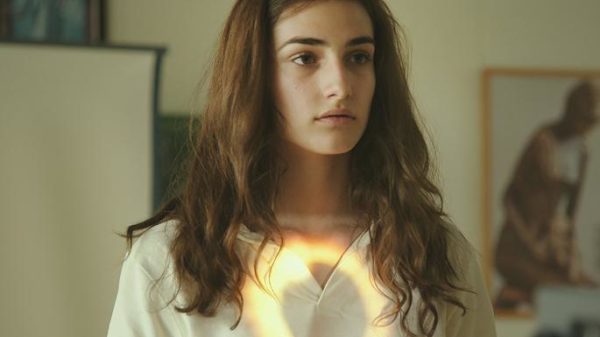
In He Said/She Said, critics Joe and Valeska dissect a film in a back and forth email exchange. Previously, we realized too late that Hellraiser: Judgment (2018) had no sights worth seeing. This time, we’re taking a spin around the Ouija board with Paco Plaza’s Verónica (2017).
Let’s bitch it out…
Synopsis: “A teen girl (Sandra Escacena) finds herself besieged by an evil supernatural force after she plays Ouija with two classmates in Madrid in 1991.”
SHE SAID
After last month’s Hellraiser debacle, I was pretty happy to be viewing Verónica for this edition of He Said/She Said. Although I don’t think that the film lives up to the “scariest film ever” hype that surrounds it, I did find it to be a very well-made, stylish, affecting, and oft-chilling supernatural horror film that (thankfully) didn’t lean too heavily on the religious aspect (I’m looking at you, Conjuring franchise). A film with so many nuns in it could easily have pushed the demon/exorcism aspect hard and I was grateful that it didn’t. I like my supernatural stories on the secular side! It’s also rife with rich symbolism and feminist themes, but we’ll get into that in a bit.
The film has a killer cold open, splicing together the audio of a 911 recording, intertitles explaining the film’s link to a real-life case, and a sequence revealing what police found when they arrived on the scene. It grabbed my attention and strongly piqued my curiosity before melting into backstory via a very clever transition. It managed to hold my attention throughout due to its excellent shot composition, great musical choices and scoring, and some fine acting by its young cast. Verónica marks the first on-screen performances by Sandra Escacena (Verónica) and Iván Chavero (Antoñito), and the first credited performance by Bruna González (Lucía). And I can’t leave out the styling and costume design! I’m a sucker for terrible early 90s fashion and I loved Verónica’s acid-washed denim backpack and her mom’s wispy bangs. The sinister Simon Says game was a great touch!
I was intrigued by the coming-of-age, sexuality, and motherhood themes present in the film. Verónica’s menarche is referenced multiple times, both in the film’s dialogue and in vivid nightmare imagery. Interestingly, the moon also plays a prominent role in the narrative – Verónica and her friends experiment with the ouija board during a mandatory eclipse-viewing at their school, sneaking off while classmates and faculty are distracted by the phenomenon. The paranormal disturbances can therefore be seen as correlating with the lunar cycle.
Of course, the moon has historically been linked to the menstrual cycle in various cultures and belief systems. Googling “puberty and paranormal activity” will lead you to a slew of articles that link the onset of menstruation with reports of heightened supernatural incidences; Plaza is clearly tapping into fertile cultural territory with this narrative and symbolism. Granted, Verónica had not yet started her period at that point in the film, but the possibility is directly and deliberately referenced in the scene immediately following her collapse during the séance, and its later onset marks an escalation in the night-time terrors.
Verónica is essentially the primary caregiver of her siblings, as her mother works full-time to support the family in the wake of her husband’s death. With Verónica essentially taking her mother’s place as the female head of the household, it’s interesting that when Verónica is first haunted by the spectre taking the shape of her father, he is nude and approaching her in her bedroom. When you add in the element of her being terrified and pinned to the bed by demonic hands, for me it raises some questions about the possibility of earlier abuse.
If we were in the mood to psychoanalyze, I think there is a lot to be said about the symbolism of that meatball scene early on; the resistance and rejection, the penetration and bloody expulsion. I don’t want to give too much away, but I think the abuse theory finds some support in the ending of the film. Is it a coincidence that so much of the tangible physical evidence of the haunting is connected with the beds of the children?
Verónica isn’t what I expected from the filmmaker who brought us 2007’s [REC] (which is not a slight against [REC] by any means). Joe, you actually saw this at a festival, if I remember correctly. What were your first impressions? What did you think upon revisiting it for this piece? And is Iván Chavero the cutest child actor since Under the Shadow’s Avin Manshadi?

HE SAID
Oh my gosh I forgot how much I loved that lazy eye and those giant glasses! Yes, Chavero’s facial reactions are adorable; his performance gives me so much joy.
So I saw this film back in September as part of the Toronto International Film Festival (TIFF), which is usually cover for Bloody Disgusting, so I reviewed Verónica then. At the time I liked it, but found certain elements too familiar, though in rereading my original review, I find my analysis a bit slight (in my defense this was my ~45th film in ten days); all excuses aside, I’m happy that I got the chance to revisit it. Watching it a second time, I definitely appreciate Plaza’s work a great deal more and I think the film is much more interesting than I originally gave it credit for.
With that said, I want to dive right into the themes of abuse you mention. It’s interesting because the film is rife with them, albeit in other, more obvious ways. When you casually mentioned it to me before my rewatch, I had no memory of any abuse. The moment that I started watching, however, I immediately remembered my initial reading, which is that the paranormal events of the film are hallucinatory stand-ins for Verónica’s unintentional abuse of her siblings (hence the strangling of Lucía, the slapping of Irene and the scalding of Antoñito). This is the “more obvious” reading of the film since it is literally represented on the screen, particularly in that climactic imagery during the climax when Verónica sees herself as the creature in the mirror before she is physically invaded by it.
I agree with you that there’s a case to be made that Verónica was being sexually abused by her father. In addition to your points, there is mom Ana’s reluctance to discuss her dead husband and Verónica’s interest in the father/daughter relationship of her neighbour, which could be interpreted as the ideal that she never got to have. Obviously it’s just as easy to suggest that Ana is still distraught over her dead husband and Verónica just misses interacting with her father, but when you begin to connect the dots, there’s certainly a darker interpretation lurking. Depending on how deep down the psychological rabbit hole we want to go, we can even marry our two readings to infer that Verónica is reenacting her father’s abuse on her siblings at the onset of her sexual awakening.
The idea of Verónica as symbolic maternal stand-in was difficult to watch both times. The film isn’t subtle about suggesting that Verónica is too young to be raising three children; why can’t she just crimp her 90s hair and go to the party?! I will say, though, that I appreciate that Plaza doesn’t make Ana the villain for being an absent, working parent. Under The Shadow and (callback to a previous He Said/She Said) A L’Interieur also unflinchingly explore the challenges and stark realities of being a single mother. I know we’re a long way off from next February’s Grim issue on Motherhood, but I feel like we’re identifying a growing subgenre of “motherhood f*cking sucks” horror flicks dying for a deeper analysis.
I liked how Plaza reinforced Verónica’s im/maturity in visual cues, like the repeated scenes when she shines a flashlight over the glow-in-the-dark stars on her bedroom ceiling. Bear with me for this: I think this combination of night lights – the flashlight and the stars – is the perfect metaphor for the evolution from childhood to adulthood. The stars are clearly childish remnants, stagnant leftovers of her past (including that too-small single bed) that serve to infantilize Verónica. The flashlight, meanwhile, is whimsical and dreamy, especially when matched with the on the nose lyrics about escaping, but it still functions as a source of light to keep the darkness at bay. When combined the two night lights reinforce Verónica’s liminal status as a teenager on the cusp of adulthood. In the immortal words of Britney: she’s “not a girl, not yet a woman.”
Stepping back a moment, the emphasis on the lunar cycle and, more broadly speaking, circles in general really stuck out on the second viewing. Verónica is repeatedly framed with symbolic circles in advance of and during the Ouija sequence – a kind of narrative bullseye that marks her as the center of the tale. Considering the framing device that enables the film to come full circle and that amazing second séance with the slooooow circular pan (my favourite sequence of the film), I’m going to go out on a limb and say that Plaza likes circles.
Valeska, before I toss it back to you, I’m intrigued by your comment about the strength of the cold open. I don’t deny that it immediately pulls you in and teases mysteries to keep an eye out for in the climax, but I’ll confess that I struggle with this kind of in medias res narrative structure. I find knowing the end (even hints of the end) deflates my excitement because I spend the remainder of the film waiting to get back to where we started. Countdowns of any kind have this impact on me (imagine how ansty I get trying to watch The ABCs of Death as each sequence counts down the letters of the alphabet!).
Did you struggle with this at all, particularly around mid-way Day 2 when we know Verónica still has a long way to go before that stormy seance? Or am I just a crazy person? Also: are we in agreement that Sister Death is a strange red herring that doesn’t really pay off?

SHE SAID
I totally agree about the possibility of the reenactment of abuse; I’m currently working on a piece for Anatomy of a Scream that explores the intergenerational abuse slant. And I’m fine with beginning with the ending, as long as the journey back around is compelling! Love your keen observations about the use of circles throughout the film — hadn’t caught all of those examples, but will look for them on my third viewing! Interesting interpretation of the night lights, as well.
Regarding Sister Death, I feel that we saw just enough of her. I appreciated her role as part-time haunting advisor and was grateful that the film didn’t pull her into the climax to chant the Lord’s Prayer at the spirit while clutching a rosary. I much preferred Verónica’s attempts to single handedly protect and care for her tiny family, without the aid of adults, using only the tools she has at her disposal — as she has been throughout the entire film.
I feel as though we’ve written about 20 pages on this film already, so I’m going to refrain from pontificating further and offer my score. I’m giving Verónica a solid 8.5 out of 10, because I love how open to interpretation so much of the symbolism is, I love the performances, and I really appreciate the cinematography. It sounds as though your score is going to be on the higher end as well?
HE SAID
Absolutely. The film is really well put together by Plaza, features a strong, capable heroine (what a performance from such a young actress!) and contains a heady mix of scares, spine tingles and atmosphere. I give Verónica an 8/10.
Now excuse me while I go dip into my collection of Spanish horror…
———–
Next month: We’re silently heading to the theater to check out real life husband and wife John Krasinski and Emily Blunt in A Quiet Place.